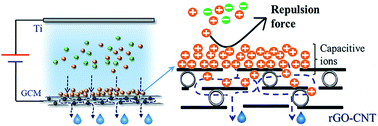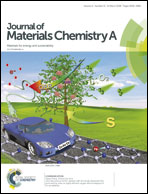Enhancement of the Donnan effect through capacitive ion increase using an electroconductive rGO-CNT nanofiltration membrane†
Abstract
Graphene oxide (GO)-based membranes in desalination suffer from either low ion rejection or low water flux. Herein, an electroconductive three-dimensional hybrid membrane was successfully fabricated using reduced GO and carbon nanotubes (GCM) and exhibited great potential to break the trade-off between permeability and selectivity when it simultaneously performed as a filter membrane and an electrode. The intercalation of carbon nanotubes (CNTs) in the reduced GO matrix not only created numerous water transport channels to promote permeability, but also increased the active adsorption sites for salt ions. The large specific surface area contributed to more capacitive counterions onto the GCM under applied bias, which resulted in stronger electrostatic repulsion between the capacitive ions on the GCM and counterions in solution, leading to an enhanced Donnan effect and remarkable salt rejection. The optimized GCM (containing 15% CNTs) achieved an outstanding NaCl rejection of 71%, which is three times higher than that without bias. Moreover, the GCM exhibited superior rejection ability for divalent cations and performed better under negative potential due to the pseudo-capacitance induced by the coordination of cations and oxygen-containing groups. These findings provide new insight for the future development of GO-based membranes.



 Please wait while we load your content...
Please wait while we load your content...